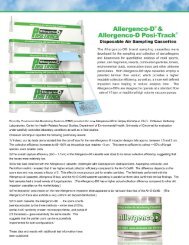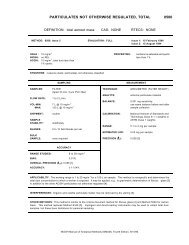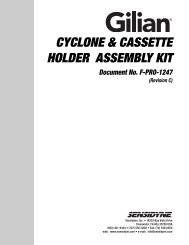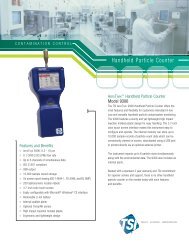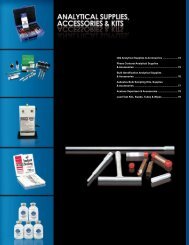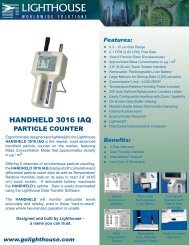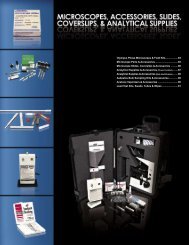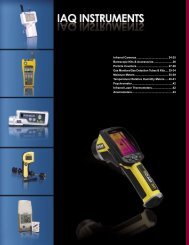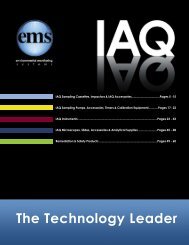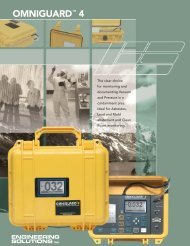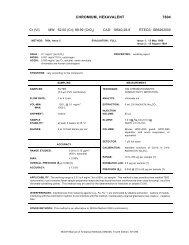NIOSH Method 7400 : Asbestos and Other Fibers by PCM
NIOSH Method 7400 : Asbestos and Other Fibers by PCM
NIOSH Method 7400 : Asbestos and Other Fibers by PCM
You also want an ePaper? Increase the reach of your titles
YUMPU automatically turns print PDFs into web optimized ePapers that Google loves.
ASBESTOS <strong>and</strong> OTHER FIBERS <strong>by</strong> <strong>PCM</strong>: METHOD <strong>7400</strong>, Issue 2, dated 15 August 1994 - Page 8 of 15NOTE: Fiber counts above 1300 fibers/mm 2 <strong>and</strong> fiber counts from samples with >50% of filterarea covered with particulate should be reported as "uncountable" or "probably biased."<strong>Other</strong> fiber counts outside the 100-1300 fiber/mm 2 range should be reported as having"greater than optimal variability" <strong>and</strong> as being "probably biased."21. Calculate <strong>and</strong> report the concentration, C (fibers/cc), of fibers in the air volume sampled, V (L),using the effective collection area of the filter, A c (approx. 385 mm 2 for a 25-mm filter):NOTE: Periodically check <strong>and</strong> adjust the value of A c , if necessary.22. Report intralaboratory <strong>and</strong> interlaboratory relative st<strong>and</strong>ard deviations (from Step 11) with eachset of results.NOTE: Precision depends on the total number of fibers counted [1,16]. Relative st<strong>and</strong>arddeviation is documented in references [1,15-17] for fiber counts up to 100 fibers in 100graticule fields. Comparability of interlaboratory results is discussed below. As a firstapproximation, use 213% above <strong>and</strong> 49% below the count as the upper <strong>and</strong> lowerconfidence limits for fiber counts greater than 20 (Fig. 1).EVALUATION OF METHOD:A. This method is a revision of P&CAM 239 [10]. A summary of the revisions is as follows:1. Sampling:The change from a 37-mm to a 25-mm filter improves sensitivity for similar air volumes. Thechange in flow rates allows for 2-m 3 full-shift samples to be taken, providing that the filter is notoverloaded with non-fibrous particulates. The collection efficiency of the sampler is not afunction of flow rate in the range 0.5 to 16 L/min [10].2. Sample Preparation Technique:The acetone vapor-triacetin preparation technique is a faster, more permanent mountingtechnique than the dimethyl phthalate/diethyl oxalate method of P&CAM 239 [2,4,10]. Thealuminum "hot block" technique minimizes the amount of acetone needed to prepare eachsample.3. Measurement:a. The Walton-Beckett graticule st<strong>and</strong>ardizes the area observed [14,18,19].b. The HSE/NPL test slide st<strong>and</strong>ardizes microscope optics for sensitivity to fiber diameter[4,14].c. Because of past inaccuracies associated with low fiber counts, the minimum recommendedloading has been increased to 100 fibers/mm 2 filter area (a total of 78.5 fibers counted in100 fields, each with field area = .00785 mm 2 .) Lower levels generally result in anoverestimate of the fiber count when compared to results in the recommended analyticalrange [20]. The recommended loadings should yield intracounter S rin the range of 0.10 to0.17 [21,22,23].B. Interlaboratory comparability:An international collaborative study involved 16 laboratories using prepared slides from the asbestoscement, milling, mining, textile, <strong>and</strong> friction material industries [9]. The relative st<strong>and</strong>ard deviations(S r) varied with sample type <strong>and</strong> laboratory. The ranges were:<strong>NIOSH</strong> Manual of Analytical <strong>Method</strong>s (NMAM), Fourth Edition, 8/15/94




